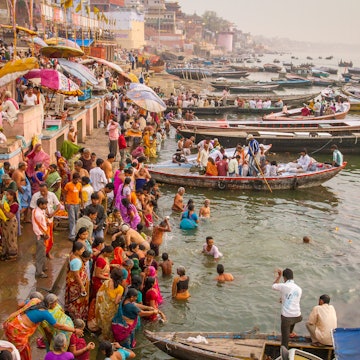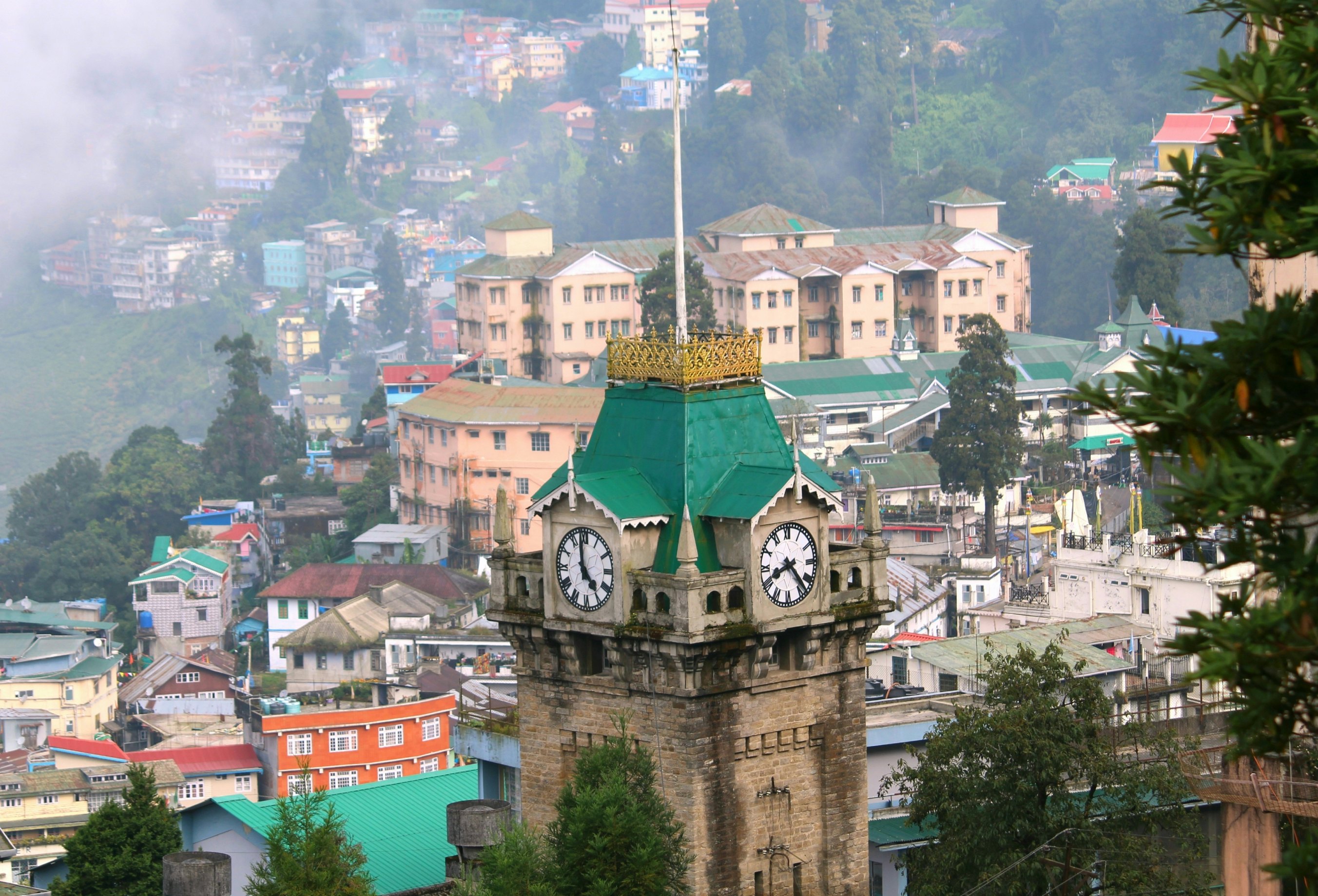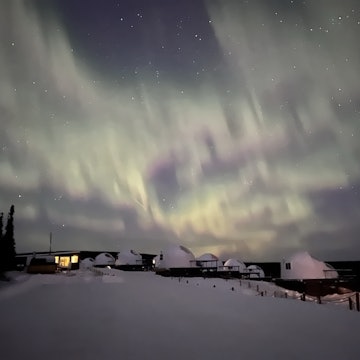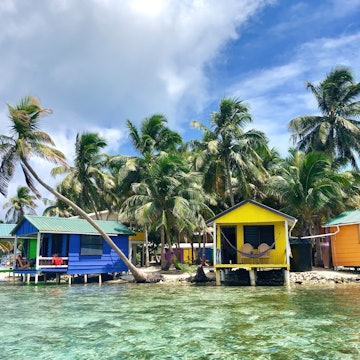

Get to know Darjeeling with this guide to the best things to do in India's "Queen of the Hills." ImagesofIndia/Shutterstock
Darjeeling is a name that many people associate with tea, but there is much more to this hill station than its delicate orange pekoe. Sprinkled along a mountain ridge at an elevation of 2100m (6900ft), it is a gateway to the high Himalayas, and sits under the icy gaze of Khangchendzonga, the world’s third-highest mountain at 8586m (28,169ft).
The historic popularity of India's “Queen of the Hills” stems, in part, from the accessibility provided by its audacious railway from Siliguri. Locomotives still belch steam as they chug into town each day. But that is nothing compared to the convoys of 4WDs (the camels of the hills) that make the hours-long journey up from the plains around Siliguri to Darjeeling along Hill Cart Rd.
Winters get chilly in the mountains, but in summer, the warm weather and natural beauty of these delightful hills are the perfect antidote to the cloying heat and dust of the plains either side of the monsoon. This is precisely what made it a favored hill station of the British East India Company in the past, and a popular destination with visitors from West Bengal and beyond today.
Darjeeling’s combination of Tibetan culture and cuisine, excellent tea, heritage relics and modern attractions make it a joy to explore. Here are the region's top experiences to get you started.

1. Watch the sunrise over some of the world’s highest mountains
Every morning, an hour before light starts diffusing into the night sky, a convoy of 4WDs trundles out of Darjeeling. The procession winds its way up the steep sides of Tiger Hill (2590m/8497ft), a peak that usually pokes above the pall of mist that envelops Darjeeling on most mornings. Sitting almost 500m (1640ft) above Darjeeling, the top of Tiger Hill offers an impeccable view of Mt Khangchendzonga. The view also takes in the more distant Mt Everest (8848m/29,032ft) and many of the world’s other highest mountains.
A murmur ripples through the crowd as the first rays of sunlight paint the face of Khangchendzonga a warm pink. Gradually, the sun clambers down to the ridge-top towns below, which sit like a tangle of fairy lights in the mist. Then the convoy fires up once more for the return trip to Darjeeling.
Planning tip: There are dozens of companies running tours to Tiger Hill from Darjeeling. Aim to get there early for a clear view, but wrap up warm. Chai wallahs work their way through the crowds of people, serving hot tea to those waiting in the cold morning air.
2. Pay homage to the great climber Tenzin Norgay
Mt Everest remained unconquered until 1953, when Edmund Hillary and his Sherpa guide Tenzin Norgay became the first people to reach its peak. Despite hailing from Nepal, Norgay is lauded like a native son in Darjeeling, where he lived for much of his life. Many of the earlier expeditions to climb Everest and other major Himalayan peaks were planned in, and started out from, Darjeeling. The Himalayan Mountaineering Institute (HMI) explores the history of these expeditions along with the geography of the mighty mountain range.
The courtyard in front of the museum (which sits in the grounds of Padmaja Naidu Himalayan Zoo) contains a statue of Norgay beside his samadhi (cremation spot) shrine. Discover more about Norgay and the other pioneering climbers, such as Hillary, who overcame the odds with minimal equipment to scale Everest, a mountain that continues to pose great risk and great fascination to climbers.

3. Take part in a prayer session
In the 1960s and '70s, Nichidatsu Fujii (aka Fuji Guruji) helped to fund and build a chain of Japanese Peace Pagodas across the world. Among the seven built in India is a fine 28m-high (92ft) specimen in Darjeeling. The gleaming white peace pagoda (also known as a shanti stupa) is a joy to visit in its own right but if you arrive at around 4:30am or 4:15pm, you can take part in a drumming puja (prayers).
Visitors are invited to enter a temple, sited below the peace pagoda, take a seat and pick up a hand drum. Follow the guidance and the beat, which is set by one of the Buddhists leading the ceremony. You can join for part of the session or remain for the entire 90 minutes.
4. Sample all four flushes of Darjeeling tea
Darjeeling is surrounded by emerald, tea bush-dotted hillsides that produce, pound for pound, India’s most expensive tea. There are 87 tea estates in the region, many of which run right to the urban fringes. You can sample this fantastic, delicate tea right from the source at a handful of tea estates open to the public.
Tours of the Happy Valley Tea Estate and factory are available throughout the year. Come between late March until mid-November, when the temperature is high enough for the tea to grow. During this time, there are four distinct harvests, the varying seasons producing teas of differing character known as “flushes.” Happy Valley estate tours end with a tasting of all four flushes.
Planning tip: During the plucking seasons, aim to visit between Tuesday and Saturday. There’s usually no plucking on Sundays, so the factories are quieter on Mondays.

5. Explore Tibetan traditions and crafts
In 1950, China invaded Tibet, annexing the country and forcing around 100,000 Tibetans to flee over the coming decades, including the Dalai Lama, who fled in 1959. Many of the refugees made their way across Tibet’s borders into Nepal and northern India. Today, Tibetans remain exiled in these places. A particularly large group is based in and around Darjeeling. The Tibetan Refugee Self-Help Centre was set up primarily as a place for empowering Tibet’s refugees to keep their traditions, heritage and crafts alive.
Located on the eastern side of Darjeeling, down the ridge from the town center, you’ll find workshops for painting, textiles and woodworking and the center, plus a photo exhibition, small Buddhist monastery and a shop where you can buy Tibetan handicrafts, carpets and other items. International shipping is available.
Planning tip: Wind your way through the tangle of streets that head downhill from Chowrasta and ask locals to point you in the right direction. Google Maps often struggles to make sense of the streets given how steep the ridge down which they tumble is.
6. Slurp down a steaming bowl of thukpa
When the Tibetan refugees came to Darjeeling, they also brought their culinary traditions with them. There are plenty of excellent restaurants around town that serve up Tibetan cuisine, such as thukpa (a hearty noodle soup) and momos (steamed savory dumplings, often served with a sesame sauce). At Noryang Tibetan Kitchen the noodles and momos are made by hand the same day, making its dishes particularly fresh and tasty.

7. Ride a steam train through the mountains
In 1879, work began on an audacious narrow-gage railway to connect Siliguri, sitting at 152m (500ft) above sea level, with Darjeeling, at 2100m (6900ft). Known as the Darjeeling Himalayan Railway (aka DHR or Himalayan Toy Train), it has since been extended to New Jalpaiguri, connecting Darjeeling to train services around India.
Originally an all-steam-powered route, these days the aging steam locomotives only ply a short stretch of the route from Darjeeling to Ghum and back (1 hour 40 minutes each way), with diesel engines now used to grind up from the plains. The rails often run parallel to, and frequently even cross, Hill Cart Rd. When the weather allows, you’ll get glimpses of Khangchendzonga beyond the tea gardens.
Planning tip: Reserve your tickets using the often frustrating website of Indian Railways, or directly at the station. Tickets are occasionally still available on the day outside of peak season.
8. Visit Observatory Hill, a place shared by two faiths
Part of the magic of India is that so many different religions and denominations are able to coexist with relatively little conflict. Sure, it’s not always rosy, but Observatory Hill is a beacon for the coexistence of world views. Located right above Darjeeling’s central Chowrasta Plaza (aka Darjeeling Mall), the hilltop is unmistakable for its dense web of both Hindu and Buddhist prayer flags, bells, small temples and yet more prayer flags. Both faiths recognize Mahakala, a Buddhist Dharma protector and incarnation of Shiva. Priests of both faiths anoint the holy, monks recite incantations and, often, Rhesus macaques cause cheeky mayhem amidst it all.

9. Learn Darjeeling’s history through its heritage buildings
Back when Darjeeling was a British East India Company hill station, it became clear that the surrounding hillsides were excellent places to grow tea. Before long, the popular beverage was bringing a steady income to the region throughout the year. Relics of this era are readily found around the triangular wedge of public space known as Chowrasta, such as St Andrew’s Church, first built in 1843. The 1850-built Clock Tower remains one of the city’s most emblematic structures.
Many of the finer buildings have become hotels. The likes of Mayfair Hill Resort, Windamere Hotel (which still offers high tea to non-guests), and the Elgin are all housed in fine heritage buildings.
A piece of heritage that often gets overlooked is the serene Bhutia Busty Gompa. It was once sited at the top of Observatory Hill until the British Raj forced its relocation. Its current secluded site, far down the slope on the east side of Chowrasta, looks out towards Khangchendzonga. Inside the temple are a series of murals depicting the life of the Buddha.
Planning tip: As with the Tibetan Refugee Self-Help Centre, Bhutia Busty Gompa is located a little over 1km (0.6 miles) downhill, east of the Chowrasta. The temple is often locked, so the murals are best seen at the 3pm prayers.
10. Join a Gymkhana Club
Another relic of British colonial rule is the Darjeeling Gymkhana Club. Built in 1909, with a billiards room, and table tennis, badminton and tennis facilities, the Gymkhana formed a central part of social life in Darjeeling. It remains a social and fitness hub. Temporary memberships are available to visitors for ₹177 (US$2.05), giving you access to most of the facilities, as well as the decent quality, cheap restaurant and cafe, during your stay.
11. Wander the gardens
The natural beauty of Darjeeling is not all lost to overdevelopment and tea estates. Its forest-clad slopes are preserved at a number of bucolic spots around the city. Foremost among them is the 40-acre Lloyd Botanic Garden, which is able to show plants and trees from three separate climatic zones, thanks to being sited on a steep slope. There’s also an orchidarium displaying some of the region’s beautiful native flowers. Further north, Shrubbery Nightingale Park’s sculpted gardens and bench-lined walkways offer good mountain views on clear days.













